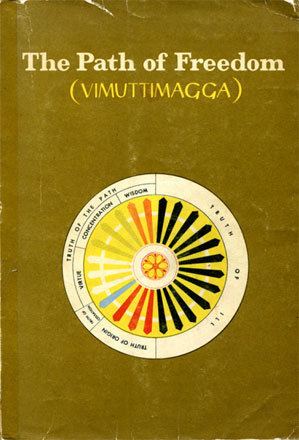10 /10 1 Votes10
| 5/5 Pariyatti Store | |||||||||||||||||||||||||||||||||
 | ||||||||||||||||||||||||||||||||||
Similar Visuddhimagga, Pāli Canon, Majjhima Nikaya, Milinda Panha, Digha Nikaya | ||||||||||||||||||||||||||||||||||
The Vimuttimagga ("Path of Freedom") is a Buddhist practice manual, traditionally attributed to the Arahant Upatissa (c. 1st or 2nd century). It was translated into Chinese in the sixth century as the Jietuo dao lun 解脫道論 by Sanghapala. The original text (possibly Pali or Buddhist Hybrid Sanskrit) is no longer extant, but the work has survived in Chinese. The book was probably written in India and then later brought to Sri Lanka. According to Bhikkhu Analayo, some doctrines of the Vimuttimagga seem to be associated with those attributed to the Abhayagiri monastery by Dhammapāla.
Contents
Contents
The Vimuttimagga recommends various meditation practices such as Anapanasati, Kasina meditation and Buddha-anussati - recollection of the virtues of the Buddha. Its chapters are (based on the translation by Ehara, Soma & Kheminda):
- Introductory Discourse (referencing the three trainings and ultimate freedom)
- On Distinguishing Virtue
- On Austerities
- On Distinguishing Concentration
- On Approaching a Good Friend
- The Distinguishing of Behavior
- The Distinguishing of the Subjects of Meditation
- Entrance into the Subject of Meditation
- The Five Forms of Higher Knowledge
- On Distinguishing Wisdom
- The Five Methods (aggregates, sense organs, elements, conditioned arising, truth)
- On Discerning Truth
Relationship to the Visuddhimagga
The Vimuttimagga bears a striking similarity to the Visuddhimagga by Buddhagosa, and it is highly probable that it had an influence on Buddhagosa. While the Visuddhimagga is a much longer work, both texts differ on several points. According to Analayo, the Vimuttimagga states that ascetic practices (dhutanga) can be unwholesome and wholesome, while the Visuddhimagga denies that they can be unwholesome. A similar difference can be seen with regards to concentration (samādhi) which the Vimuttimagga states can be wholesome or unwholesome (micchā samādhi/邪定) while the Visuddhimagga disagrees that it can be unwholesome. Another major difference is in the scheme of the progress of insight, which the Vimuttimagga arranges based on the four noble truths and the Visuddhimagga arranges based on the seven purifications which stem from the Rathavinīta-sutta.
Minor differences can also be seen in the particular schemes of practice. Upatissa gives four categories of Śīla while Buddhagosa gives five. Upatissa gives four ways of cultivating Anapanasati, while Buddhagosa gives eight. In addition, the Visuddhimagga identifies forty subjects of meditation (kammatthana) while the Vimuttimagga identifies thirty-eight.
